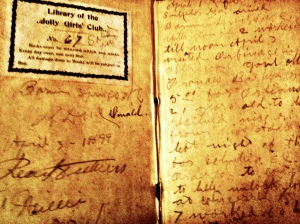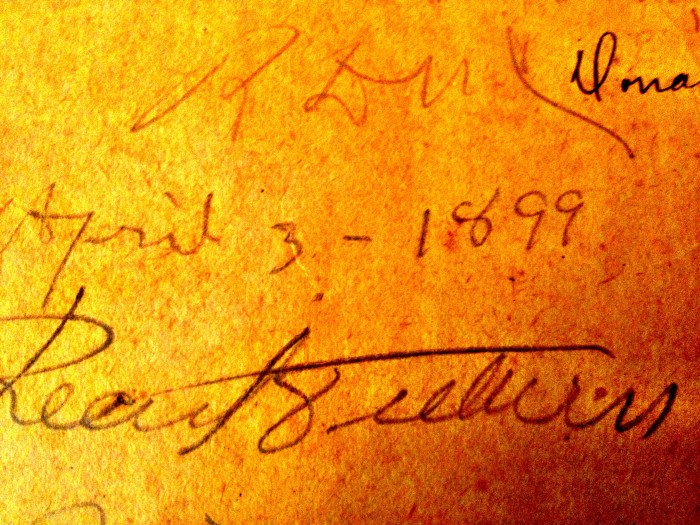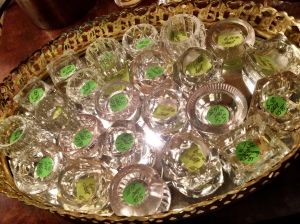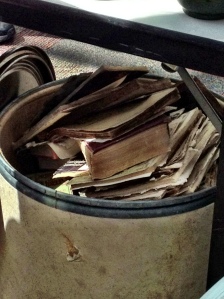Devoting oneself to the study of artifacts by default means thinking in terms of obsolescence. For the contents of the curiosity shop are often those forlorn orphans unable to cross over into modern aesthetics or make themselves useful to 21st-century life.
Let’s face it. Kindles have a lot on printed books. And Kindles are good—great—for a very many things. But Kindles cannot record human history, or serve as an artifact, quite the way a book can. It can’t smell or feel like a book. It can’t wear or age like one. You can’t find random scraps and slips of notepaper or envelopes tucked inside its pages—a postcard here, a recipe there—somebody sometime’s impromptu bookmarks… Old books tell more than simply the stories printed onto their pages—if we know where to look. And something else books have on Kindles? Inscriptions.
I cannot pass up a good inscription on the vintage market. (Nor should you.) And did you ever notice how many old books are inscribed?
The inscription—names, dates, occasions, the penmanship of yore in ink or pencil—harks back to a time when books were special gifts and school prizes, property to be earned, collected, and laid claim to. A time when books were valuable—for the entertainment they promised or the knowledge they contained. A time when the personal library, the mark of a discriminating home and culturally literate mind, was built over the course of a lifetime and showcased prominently—in the home as well as in social life. (Even if that’s a bunch of nostalgia, it’s still partly true. My grandparents had bookshelves all over their living room; my parents had floor-to-ceiling shelves built into the study. These were all filled with books. These days, my friends (not you, Lady B) also have built-ins, but you won’t find many books lining the shelves.)
Sadly, the curiosity shop, that weathervane of time and taste, does not bode well for the printed book. How telling that old volumes—probably bought in lots for pennies at auction—are dumped here in buckets or stacked in such numbers they threaten to topple. The very arrangement of these old books is daunting enough—shoved into already bursting and bowed shelves, towering precariously in booth corners. Dealers stretch the limits of their imagination to find relevant uses for them (stacked into legs for a side table? Used a few at a time as intellectual décor? I’ve even seen old pages turned into Christmas ornaments on Etsy). Since, come on, does anyone read actual books these days (and if they do, then are they reading these titles)? (Besides you again, Lady B.) After all, books suffer a double jeopardy, inside and out. Their contents can be as antiquated as their bulky form.
Inscriptions make buying old books worthwhile—no matter what the title. These elegant pen-and-ink scripts in bygone fonts–even the plainest penciled signature a minor work of art. Many of these pages are frame-worthy in their own right. This is why it is so sad to see a solid old hardcover with a lovely, artistic inscription decorating the front papers among estate sale leftovers or shoved into booth corners where only the heartiest, most pathological scavenger will ever pick through the wreckage and find it.
Consider. Technology can do a lot, but would a Kindle have led me to the Jolly Girls’ Club? It’s doubtful. But a faded old book with compromised binding did.

Property of the Library of the Jolly Girls’ Club. Old-school social networking preserved for the 21st-century.
I was poking around a favorite sprawling antique mall upstate on the North Carolina line, testing my theory about the prevalence of inscriptions once upon a time. Not only were the volume’s front papers totally covered in (unfortunately undecipherable) penciled notes, but the Jolly Girls’ Club sticker stretched clear across the 20th century right into my world. What vintage enthusiast wouldn’t be captivated by such a wonderfully quaint name? What detective of the passé (or fan of the full range of popular TV picking programs) wouldn’t need to find out more? These girls’ and women’s clubs, popular into the first half of the 20th century , fostered—guess what?—social networks. Old school. Like, in person. Clubs met regularly, usually at a member’s home or sometimes at a community center; they discussed current events, competed in sporting events, and shared recipes; they brought potluck; they hosted lecturers; they maintained lending libraries. The idea was edification, community, knowledge. In short, betterment—personal, intellectual, and domestic—and particularly for the more provincial who did not have easy access to the cultural attractions of the cities. Club details—hostess, main business, next meeting—were published in local newspapers. The whole thing is as charmingly archaic as local newspapers themselves. The book I held was central—somehow—to the enterprise. Perhaps it was borrowed at one time by Miss Daisy Smith, whose engagement to Mr. Ronald Carroll was celebrated by her Club (as announced in her town paper) with a shower of kitchen wares in May of 1913 at the home of the alliterative Mrs. L.L. Little.
The fundamental ironies of lamenting the passage of the old-fashioned and endangered inscription via digital media do not escape me. Technology allows for researching Jolly Girls’ Clubs and discoursing on the beauty of the vanishing art form of the inscription. But devices like the Kindle cannot give you the actual unique handwriting (another lost art) of a great-grandparent—the bite of the pen tangible on the page—or the peculiar feel of an object held once in the hands of Someone Else whose fingers turned through the same pages. That sense of continuity and connectedness, that passing down of a tradition if not literary taste, that evidence of the human condition writ small is not (yet) a setting on our Kindles.
Are books on their way out? I do hope not. But you know what else you tend to find at the curiosity shop? Bookshelves.





